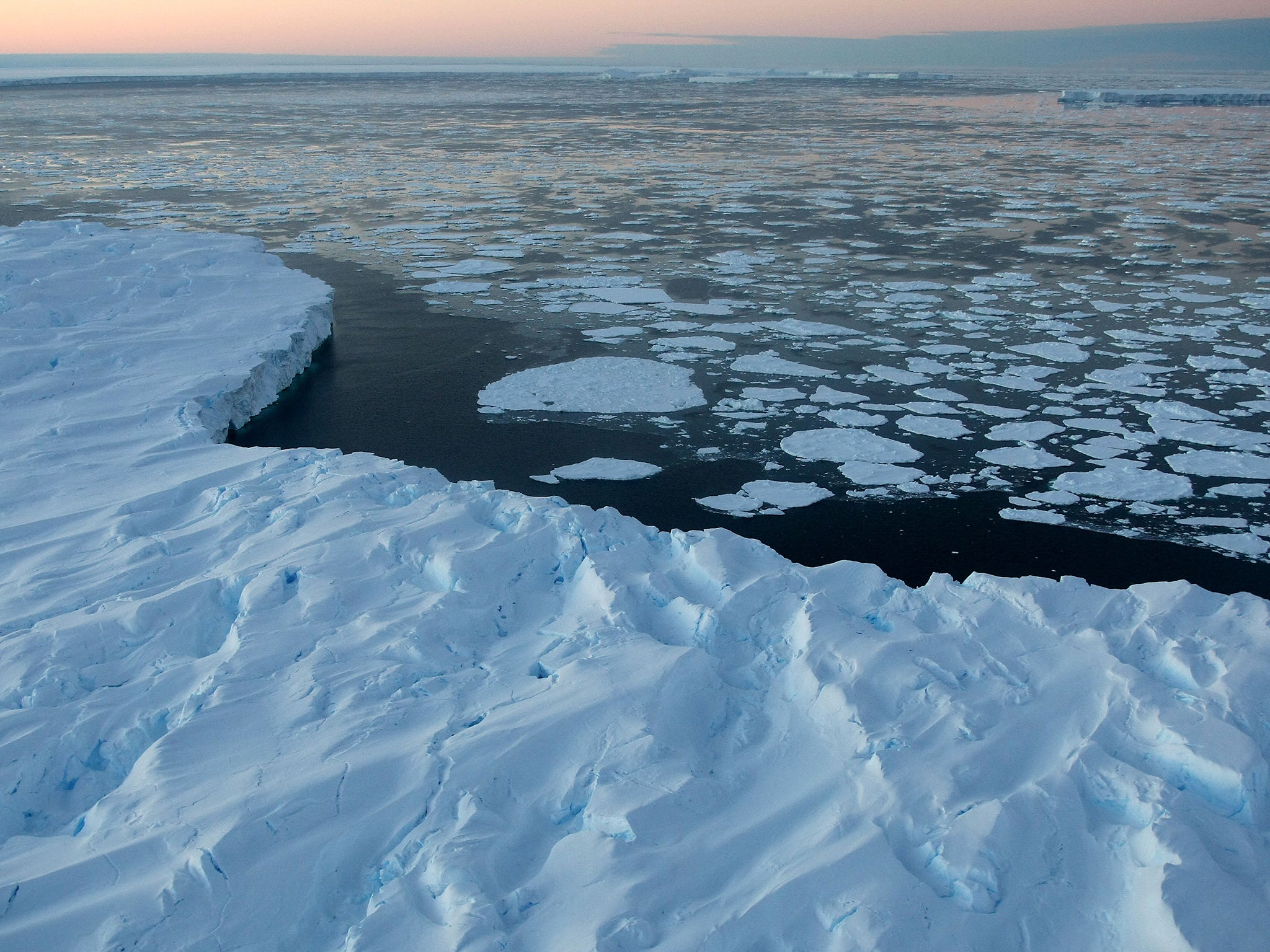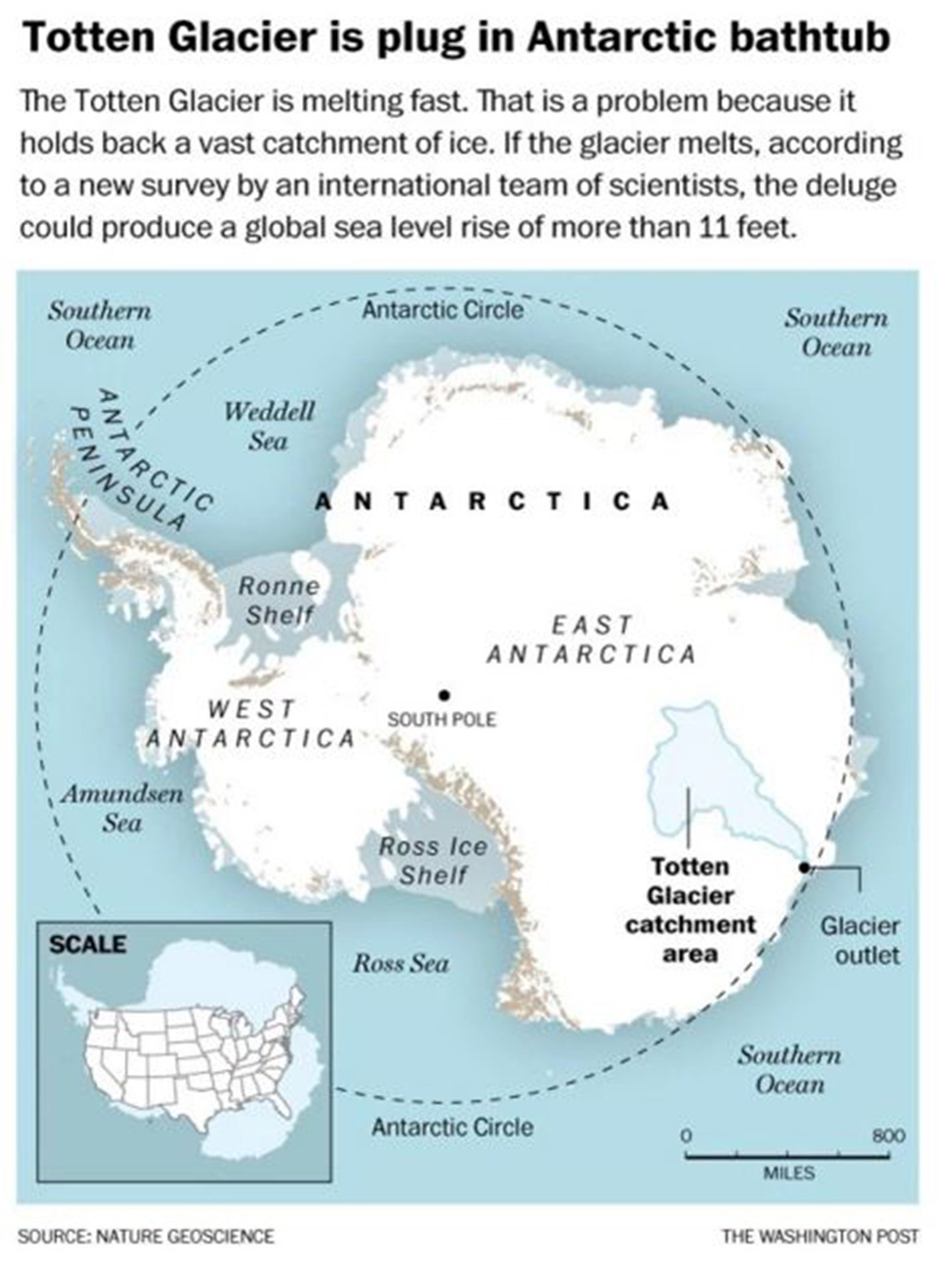East Antarctica’s biggest glacier is melting from below, study says
Totten Glacier has a 5km wide valley beneath its ice shelf that could enable warm water to reach its base

Your support helps us to tell the story
From reproductive rights to climate change to Big Tech, The Independent is on the ground when the story is developing. Whether it's investigating the financials of Elon Musk's pro-Trump PAC or producing our latest documentary, 'The A Word', which shines a light on the American women fighting for reproductive rights, we know how important it is to parse out the facts from the messaging.
At such a critical moment in US history, we need reporters on the ground. Your donation allows us to keep sending journalists to speak to both sides of the story.
The Independent is trusted by Americans across the entire political spectrum. And unlike many other quality news outlets, we choose not to lock Americans out of our reporting and analysis with paywalls. We believe quality journalism should be available to everyone, paid for by those who can afford it.
Your support makes all the difference.Earlier this year, we learned some worrisome climate news. Although Antarctic scientists have been most concerned about loss of ice in the western part of Antarctica, a study in Nature Geoscience suggested a vulnerability in the much larger ice sheet of East Antarctica, as well.
East Antarctica’s enormous Totten Glacier, you see, has a key similarity with the glaciers of West Antarctica — namely, it is rooted deep below sea level. This means that it is potentially exposed to warm ocean waters, and the study in March uncovered a deep and 5-kilometer wide subsea valley beneath the glacier’s oceanfront ice shelf that, the authors said, could be a route for warm offshore water to reach its base. This might explain why the glacier has been observed to be thinning and lowering, or losing elevation, over time, they noted.
Located along East Antarctica’s Sabrina Coast, Totten glacier is the ice sheet’s largest. It holds back 3.9 meters of potential sea level rise, or over 12 feet, and connects with the very deep and vast Aurora Subglacial Basin, which is also rooted well below sea level. So the results were treated as being of enormous consequence.
But they’re not the end of the story, as there is vastly more to learn about Totten glacier. A new study out in Geophysical Research Letters reaffirms some of these core concerns about Totten’s melt — while also appearing to partly alleviate others.
Xin Li, a researcher at the University of California, Irvine, worked with a team from her institution and NASA’s Jet Propulsion Laboratory to examine Totten using satellite imagery and aircraft data. The researchers documented for the first time just how much the glacier’s “grounding line” — the critical underwater area where ice, bedrock and the ocean meet — has been retreating inland over the years.
The answer is quite a bit. The research found that between 1996 and 2013 Totten’s grounding line retreated as much as 3 kilometers in some places. That’s fast, but it’s not nearly so fast as what has been happening in West Antarctica, where the retreat in some areas has been as much as one to two kilometers per year.
“This boundary is very important because that’s where the ice detaches from the bed and becomes afloat and frictionless,” says Li of the grounding line. So any change here is not good news. The researchers were only able to get data for 20 percent of the vast Totten glacier’s grounding line, but this region accounted for 70 percent of the glacier’s current ice loss into the ocean, and for its fastest thinning.

A sigh of relief about Totten?
A key question thus becomes whether the grounding line in this area could speed up its retreat and in particular, whether a “marine ice sheet instability,” which is thought to exist in West Antarctica, might also exist here. Such an instability is caused by the presence of a “retrograde” or downward-sloping seabed beneath the glacier, which means that warm water can continually get beneath the ice sheet as the grounding line retreats further and further downhill.
The answer, the new study suggests, is no. “Immediately upstream of the grounding line there is a 7 kilometer long region — we call it an ice plain because the slopes are really flat, and for this part of the glacier, it could retreat very fast, in a couple of decades or so,” says Li. After that, though, the elevation actually rises for 40 kilometers, and so the retreat would not happen as quickly.
“The bedrock topography at the end of the present Totten fjord (beneath the floating thick ice at the glacier front) is such that retreat is likely to proceed rapidly but then slow down,” observes Ted Scambos, lead scientist at the National Snow and Ice Data Center, who reviewed the new study for the Post. “There will be a glacier acceleration and thinning associated with the first retreat into a deep area but then some slowing.”
“This is an area harder to destabilize dramatically than in Thwaites area” of West Antarctica, adds Penn State University glaciologist Richard Alley, commenting on the new study. But, he continues, “warming waters can influence this area and access a lot of ice leading to long-term large sea-level rise.”
The new study, however, was not able to confirm or refute the existence of the canyon from the earlier paper in Nature Geoscience. There was no data available for the relevant area on the eastern side of the glacier — so this remains a possible route for how warm water may be reaching the glacier’s grounding line.
What’s the bigger worry — Totten or Thwaites?
A clear subtext of the new research is that the Thwaites glacier in West Antarctica is a bigger sea level threat than Totten — at least in the short term. But not everyone is so sure that the new research, in its delineation of what the bedrock is like near one key part of the Totten grounding line, does much to lessen concern about the region and its potential for eventually causing large sea level rise.
Totten glacier “is super sensitive to that geometry, but it’s also super sensitive to the reorganization of the ocean, and how much heat is delivered,” says Don Blankenship, one of the authors of the Nature Geoscience study and a geoscientist at the University of Texas at Austin. Earlier this year, the Australian Antarctic Division reported ship measurements suggesting that warm ocean water is indeed reaching Totten glacier.
In other words, Blankenship agrees with Li that the bedrock topography could temporarily slow down Totten’s retreat. But he thinks the warm ocean is more than powerful enough to overcome such a temporary hindrance over time – and after that, he says, the bedrock slopes down into the deep Aurora Subglacial Basin.
Blankenship’s UT Austin colleagues and co-authors Duncan Young and Jamin Greenbaum, meanwhile, have discovered what they say is smaller region of potential marine ice sheet instability near the ocean trench. The grounding line in this area was not mapped in the new study because of a lack of data.
Finally, they point to recent research suggesting new mechanisms that can destabilize truly gigantic and mostly submerged glaciers, like Totten, which are rooted well over 1,000 meters below sea level but also have ice extending over 100 meters into the air above sea level. If these glaciers lose their stabilizing ice shelves, the research suggests, then “ice cliff failure” will occur whenever there is a sheer ice face more than 100 meters high above the sea level.
Therefore, these researchers say they are still looking at Totten glacier as a potential key to solving one of the most important mysteries in climate research: In past eras of Earth’s history that weren’t all that much warmer than today, scientists believe seas were much, much higher – so much so that not even a collapse of West Antarctica, alone, could account for it. Thus, they’re busy looking for the missing ice – or, the missing ocean water – that will balance these past sea level budgets. And they think Totten and the Aurora basin could be the place that it came from.
Clearly, more data gathering will be very important — and will contribute to a continuing reassessment of the long-term vulnerability of East Antarctica, and especially this region. As Tas van Ommen, a senior scientist with the Australia Antarctic Division and also one of the authors of the Nature Geoscience paper, recently wrote:
Previously we thought that, aside from a poorly mapped valley far inland of Casey known as Aurora Basin, most of the ice was resting on bedrock hills and mountains above sea level. It turns out that Aurora Basin is very deep and much larger than we thought. More seriously, the basin is connected to the coast by terrain that is extensively below sea level. This makes it much more like West Antarctica, where there is concern that gradual, but irreversible ice loss is underway. The prospect that such a pattern could also impact East Antarctica is a new one, and suggests that changes to the Totten Glacier might be the first stages of such accelerating loss in East Antarctica.
Thus, the new research on Totten glacier, in the end, probably has two separate, important messages.
First, it reemphasizes that Thwaites glacier, of West Antarctica, is likely the number one place that we should be worried about potentially delivering a lot of sea level rise on a time scale relevant to the people living today, and their children and grandchildren. That’s why Antarctic scientists are clamoring to do vastly more research there — immediately.
© Washington Post
Join our commenting forum
Join thought-provoking conversations, follow other Independent readers and see their replies
Comments